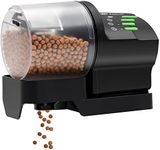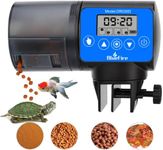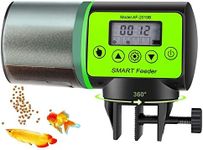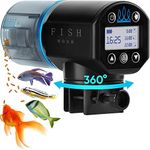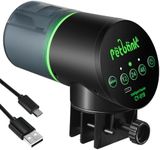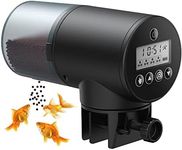Buying Guide for the Best Automatic Fish Feeders
Choosing the right automatic fish feeder can make caring for your aquarium much easier, especially if you travel or have a busy schedule. The goal is to find a feeder that reliably dispenses the right amount of food at the right times, keeping your fish healthy and your tank clean. When shopping, focus on how the feeder fits your tank size, the type of food you use, and how much control you want over feeding schedules. Understanding the key features will help you pick a feeder that matches your needs and keeps your fish happy.Feeding CapacityFeeding capacity refers to how much food the feeder can hold at one time. This is important because it determines how long the feeder can operate before needing a refill. Small capacity feeders are suitable for small tanks or short trips, while larger capacity feeders are better for bigger tanks or longer periods away. If you have a lot of fish or plan to be away for a week or more, look for a feeder with a larger food container. For daily use or smaller tanks, a compact feeder may be enough.
Feeding Schedule and TimerThe feeding schedule and timer feature lets you set how often and when the feeder dispenses food. Some feeders offer simple daily timers, while others allow multiple feedings per day or even different schedules for each day. If your fish require frequent or specific feeding times, choose a feeder with a programmable timer. For basic needs, a simple once-a-day timer may be sufficient. Think about your fish’s eating habits and your routine to decide how much flexibility you need.
Food Type CompatibilityNot all feeders work with every type of fish food. Some are designed for flakes, others for pellets, granules, or even freeze-dried foods. Using the wrong type can cause clogs or uneven feeding. Check what kind of food your fish eat and make sure the feeder is compatible. If you use a mix of foods, look for a versatile feeder that can handle different shapes and sizes. Matching the feeder to your preferred food type ensures reliable operation and healthy fish.
Moisture ResistanceMoisture resistance is about how well the feeder keeps food dry and prevents clumping. In humid environments or open tanks, moisture can cause food to stick together and block the feeder. Some feeders have special seals or air-tight containers to keep food dry. If your tank is uncovered or you live in a humid area, prioritize a feeder with good moisture protection. For covered tanks in dry rooms, this may be less critical.
Ease of Use and CleaningEase of use and cleaning refers to how simple it is to set up, refill, and clean the feeder. Complicated feeders can be frustrating and may lead to mistakes in feeding. Look for feeders with clear instructions, easy-to-open containers, and parts that can be washed. If you prefer low-maintenance equipment, choose a feeder known for its user-friendly design. This will save you time and help keep your fish healthy.
Power SourceAutomatic fish feeders can be powered by batteries, electricity, or both. Battery-powered feeders offer flexibility and can be placed anywhere, but you’ll need to check and replace batteries regularly. Electric feeders don’t need battery changes but must be near a power outlet. Some feeders offer both options for backup. Consider where your tank is located and how often you want to check the feeder to decide which power source is best for you.





